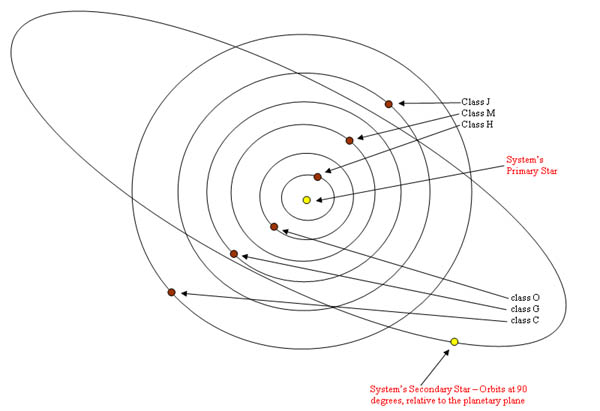Luxis system: Difference between revisions
m (creating entry) |
(readded to NCE using new index system) |
||
| (5 intermediate revisions by 3 users not shown) | |||
| Line 1: | Line 1: | ||
{{system | {{system | ||
|region= | |region=unclaimed | ||
|sector= | |sector=[[Duronis Sector]] | ||
|affiliation=Independent | |affiliation=Independent | ||
|type=Binary | |type=Binary | ||
|suns=2 ([[Luxis]], [[Sebris]]) | |suns=2: ([[Luxis]], [[Sebris]]) | ||
|planets=6 | |planets=6 | ||
|objects=[[Sebrin Asteroid Belt|asteroid belt]] | |objects=[[Sebrin Asteroid Belt|asteroid belt]] | ||
|interest= | |interest=[[Duronis II]], [[Subspace Sandbar]] | ||
|species=[[ | |species=[[Laudean]] | ||
|otherspecies=numerous | |otherspecies=numerous | ||
}} | }} | ||
{{Luxis}} | {{Luxis}} | ||
==Historical Note== | |||
Obviously Starfleet has called the system Duronis, so the primary star would be Duronis A and the secondary Duronis B, the planets would be Duronis I, Duronis II, etc. The Laudeans, however, call their primary sun [[Luxis]] and the secondary star [[Sebris]]. The planets (in order) are called Dil'ahn, [[Til'ahn]], Rhil'ahn, Nil'ahn, Sil'ahn, and Pil'ahn. The suffix ''''ahn''' means "world". '''Til''' means "home". Dil, Rhil, Nil, Sil, and Pil were brothers in Laudean mythology/cosmology. Luxis and Sebris were their parents. Til'ahn's two moons are [[Jareb]] (class D), and [[Mareb]] (class Y). | |||
==Anomalies== | |||
*''[[Sebrin Asteroid Belt|Asteroid Field]]'': Circling the system secondary (once a class M, but destroyed by tidal forces when the secondary star was captured by the gravity well of the primary star. Some of the larger remnants still have very thin atmospheres and could be considered class-D.) | |||
*''[[Subspace Sandbar]]'': This covers much of the system, but there is one narrow corridor inside of which warp travel is possible. This allows Warp 2 (max speed in the corridor) travel to within 6 hours of the system's star (full impulse speed allowed from there). The Laudeans found this corridor early in their space travel history using their Fielding powers. | |||
<center>[[image:Embassy_System.jpg]]</center> | <center>[[image:Embassy_System.jpg]]</center> | ||
==Interstellar Location== | ==Interstellar Location== | ||
The Duronis system is not located within Federation space. In a region of relatively unexplored space, the Duronis system is located in unclaimed territory between the [[ma:Romulan Star Empire|Romulan Star Empire]] and the [[ma:Zalkonian|Zalkonian]] [[Political Sovereignty|Suzerainty]] (in the Beta Quadrant.) | |||
To view the Duronis system's location in comparison to the rest of the United Federation of Planets see this [[Starchart, UFOP|starchart]]. | |||
To view the Duronis | |||
=== | ===Nearby systems=== | ||
(In order of nearest to furthest) | (In order of nearest to furthest) | ||
| Line 51: | Line 35: | ||
* [[Typhon Expanse|The Typhon Expanse]] (= hazardous) | * [[Typhon Expanse|The Typhon Expanse]] (= hazardous) | ||
* [[Zakdorn]] | * [[Zakdorn]] | ||
* [[ | * [[Deep Space 6]] | ||
* [[ | * [[ma:Starbase 185|Starbase 185]] | ||
* [[Jouret]] | * [[Jouret]] | ||
* [[Ivor]] | * [[Ivor]] | ||
* [[ | * [[ma:Deep Space 5|Deep Space 5]] | ||
* [[Typhon Sector|The Typhon Sector]] | * [[Typhon Sector|The Typhon Sector]] | ||
* [[Tarod]] | * [[Tarod]] | ||
| Line 61: | Line 45: | ||
[[Category:Systems]] | [[Category:Systems]] | ||
[[Category:Duronis System|*]] | [[Category:Duronis System|*]] | ||
{{NC}} | |||
Latest revision as of 03:29, 26 April 2014
| Luxis system | |

| |
| Astrographical Information | |
|---|---|
| Region | unclaimed |
| Sector | Duronis Sector |
| Affiliation | Independent |
| System Information | |
| Type | Binary |
| Sun(s) | 2: (Luxis, Sebris) |
| Planets | 6 |
| Other Members | asteroid belt |
Of Interest |
Duronis II, Subspace Sandbar |
| Inhabitants | |
Native Species |
Laudean |
| Other Species | numerous |
| Last Updated: 239104.26 | |
| Luxis system | Star-A • I • II • III • IV • Star-B • Belt • V • VI |
Historical Note
Obviously Starfleet has called the system Duronis, so the primary star would be Duronis A and the secondary Duronis B, the planets would be Duronis I, Duronis II, etc. The Laudeans, however, call their primary sun Luxis and the secondary star Sebris. The planets (in order) are called Dil'ahn, Til'ahn, Rhil'ahn, Nil'ahn, Sil'ahn, and Pil'ahn. The suffix 'ahn means "world". Til means "home". Dil, Rhil, Nil, Sil, and Pil were brothers in Laudean mythology/cosmology. Luxis and Sebris were their parents. Til'ahn's two moons are Jareb (class D), and Mareb (class Y).
Anomalies
- Asteroid Field: Circling the system secondary (once a class M, but destroyed by tidal forces when the secondary star was captured by the gravity well of the primary star. Some of the larger remnants still have very thin atmospheres and could be considered class-D.)
- Subspace Sandbar: This covers much of the system, but there is one narrow corridor inside of which warp travel is possible. This allows Warp 2 (max speed in the corridor) travel to within 6 hours of the system's star (full impulse speed allowed from there). The Laudeans found this corridor early in their space travel history using their Fielding powers.

Interstellar Location
The Duronis system is not located within Federation space. In a region of relatively unexplored space, the Duronis system is located in unclaimed territory between the Romulan Star Empire and the Zalkonian Suzerainty (in the Beta Quadrant.)
To view the Duronis system's location in comparison to the rest of the United Federation of Planets see this starchart.
Nearby systems
(In order of nearest to furthest)
- Sector 9569
- The Zeta Gellis Cluster
- Systems in Zalkonian Space & Systems in Romulan Space
- The Typhon Expanse (= hazardous)
- Zakdorn
- Deep Space 6
- Starbase 185
- Jouret
- Ivor
- Deep Space 5
- The Typhon Sector
- Tarod